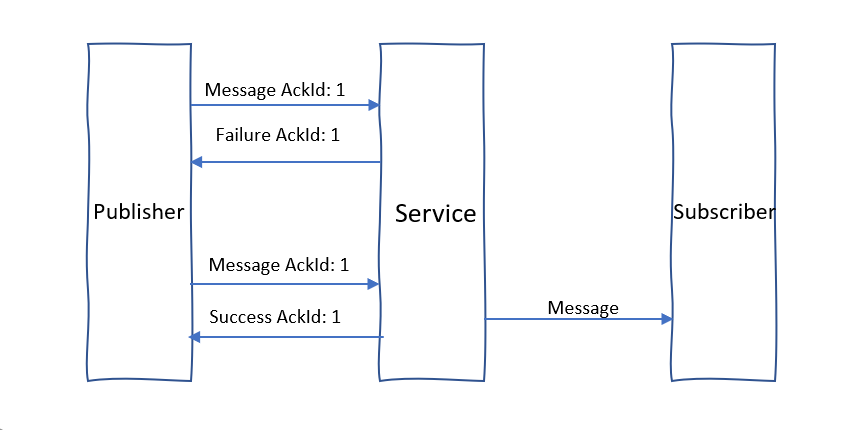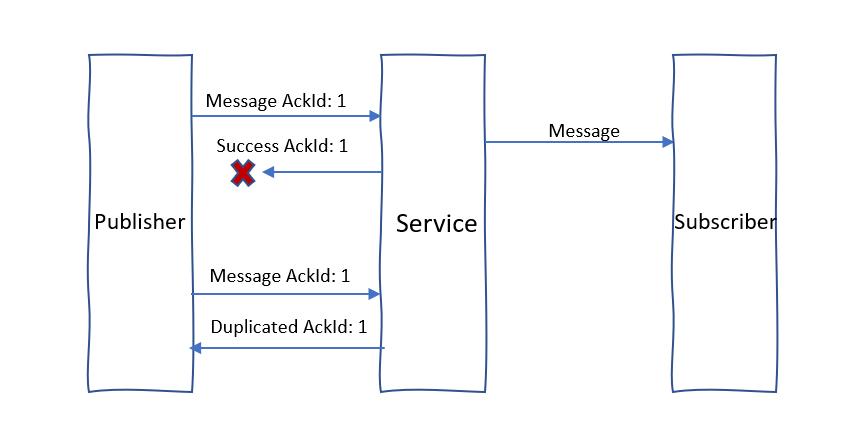Create reliable Websocket with subprotocol
When Websocket client connections drop due to intermittent network issues, messages can be lost. In a pub/sub system, publishers are decoupled from subscribers, so publishers may not detect a subscribers' dropped connection or message loss. It's crucial for clients to overcome intermittent network issues and maintain reliable message delivery. To achieve that, you can create a reliable Websocket client with the help of reliable Azure Web PubSub subprotocols.
Reliable Protocol
The Web PubSub service supports two reliable subprotocols json.reliable.webpubsub.azure.v1 and protobuf.reliable.webpubsub.azure.v1. Clients must follow the publisher, subscriber, and recovery parts of the subprotocol to achieve reliability. Failing to properly implement the subprotocol may result in the message delivery not working as expected or the service terminating the client due to protocol violations.
The Easy Way - Use Client SDK
The simplest way to create a reliable client is to use Client SDK. Client SDK implements Web PubSub client specification and uses json.reliable.webpubsub.azure.v1 by default. Please refer to Publish/subscribe among clients for quick start.
The Hard Way - Implement by hand
The following tutorial walks you through the important part of implementing the Web PubSub client specification. This guide is not for people looking for a quick start but who wants to know the principle of achieving reliability. For quick start, please use the Client SDK.
Initialization
To use reliable subprotocols, you must set the subprotocol when constructing Websocket connections. In JavaScript, you can use the following code:
Use Json reliable subprotocol:
var pubsub = new WebSocket( "wss://test.webpubsub.azure.com/client/hubs/hub1", "json.reliable.webpubsub.azure.v1" );Use Protobuf reliable subprotocol:
var pubsub = new WebSocket( "wss://test.webpubsub.azure.com/client/hubs/hub1", "protobuf.reliable.webpubsub.azure.v1" );
Connection recovery
Connection recovery is the basis of achieving reliability and must be implemented when using the json.reliable.webpubsub.azure.v1 and protobuf.reliable.webpubsub.azure.v1 protocols.
Websocket connections rely on TCP. When the connection doesn't drop, messages are lossless and delivered in order. To prevent message loss over dropped connections, the Web PubSub service retains the connection status information, including group and message information. This information is used to restore the client on connection recovery
When the client reconnects to the service using reliable subprotocols, the client will receive a Connected message containing the connectionId and reconnectionToken. The connectionId identifies the session of the connection in the service.
{
"type": "system",
"event": "connected",
"connectionId": "<connection_id>",
"reconnectionToken": "<reconnection_token>"
}
Once the WebSocket connection drops, the client should try to reconnect with the same connectionId to restore the same session. Clients don't need to negotiate with the server and obtain the access_token. Instead, to recover the connection, the client should make a WebSocket connect request directly to the service with the service host name, connection_id, and reconnection_token:
wss://<service-endpoint>/client/hubs/<hub>?awps_connection_id=<connection_id>&awps_reconnection_token=<reconnection_token>
Connection recovery may fail if the network issue hasn't been recovered yet. The client should keep retrying to reconnect until:
- The Websocket connection is closed with status code 1008. The status code means the connectionId has been removed from the service.
- A recovery failure continues to occur for more than 1 minute.
Publisher
Clients that send events to event handlers or publish messages to other clients are called publishers. Publishers should set ackId in the message to receive an acknowledgment from the Web PubSub service that publishing the message was successful or not.
The ackId is the identifier of the message, each new message should use a unique ID. The original ackId should be used when resending a message.
A sample group send message:
{
"type": "sendToGroup",
"group": "group1",
"dataType": "text",
"data": "text data",
"ackId": 1
}
A sample ack response:
{
"type": "ack",
"ackId": 1,
"success": true
}
When the Web PubSub service returns an ack response with success: true, the message has been processed by the service, and the client can expect the message will be delivered to all subscribers.
When the service experiences a transient internal error and the message can't be sent to subscriber, the publisher will receive an ack with success: false. The publisher should read the error to determine whether or not to resend the message. If the message is resent, the same ackId should be used.
{
"type": "ack",
"ackId": 1,
"success": false,
"error": {
"name": "InternalServerError",
"message": "Internal server error"
}
}

If the service's ack response is lost because the WebSocket connection dropped, the publisher should resend the message with the same ackId after recovery. When the message was previously processed by the service, it will send an ack containing a Duplicate error. The publisher should stop resending this message.
{
"type": "ack",
"ackId": 1,
"success": false,
"error": {
"name": "Duplicate",
"message": "Message with ack-id: 1 has been processed"
}
}

Subscriber
Clients that receive messages from event handlers or publishers are called subscribers. When connections drop due to network issues, the Web PubSub service doesn't know how many messages were sent to subscribers. To determine the last message received by the subscriber, the service sends a data message containing a sequenceId. The subscriber responds with a sequence ack message:
A sample sequence ack:
{
"type": "sequenceAck",
"sequenceId": 1
}
The sequenceId is a uint64 incremental number in a connection-id session. Subscribers should record the largest sequenceId it has received, accept only messages with a larger sequenceId, and drop messages with a smaller or equal sequenceId. The subscriber should ack with the largest sequenceId it recorded, so that the service can skip redelivering messages that subscribers have already received. For example, if the subscriber responds with a sequenceAck with sequenceId: 5, the service will only resend messages with a sequenceId larger than 5.
All messages are delivered to subscribers in order until the WebSocket connection drops. With sequenceId, the service can know how many messages subscribers have received across WebSocket connections in a session. After a WebSocket connection drops, the service will redeliver messages not acknowledged by the subscriber. The service stores a limited number of unacknowledged messages. When the number of messages exceed the limit, the service will close the WebSocket connection and remove the session. Thus, subscribers should ack the sequenceId as soon as possible.
Feedback
Coming soon: Throughout 2024 we will be phasing out GitHub Issues as the feedback mechanism for content and replacing it with a new feedback system. For more information see: https://aka.ms/ContentUserFeedback.
Submit and view feedback for